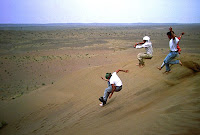Gilian Ice and Darna Dufour from the Ohio University are preparing a book about disasters that happened to people during their field work! Today, Philip Cantino sent around this message via the taxacom list which mainly addresses biologists. However, I hope this message is also spread among geologists. Many heroic situations in exotic places have been experienced by some geobloggers (e.g. reprted here ,here, here, here, here, here, here, here , here, here , here, here, and here). I could imagine you could also tell hundreds of desaster stories ;)
Here is the message sent around today by the taxacom list:
Call for Disasters in the Field Submissions
Have you ever had essential equipment fail when you are in the middle of the jungle? A difficult student? Research permission revoked in the middle of the project? Been struck by lightning? Dropped your camcorder in a river? We need your stories about
challenges in field research. We all know that the old adage, "what can go wrong, will go wrong" often holds true when we do international field research. However, we all find creative ways of working around these potential disasters. We are working on a book titled, Disasters in the Field: Preparing for and Coping with Unexpected Events to be published by Altamira Press. The purpose is to present students and researchers with an overview of problems associated with doing international fieldwork-to provide them with practical suggestions that will help them prepare for the field and minimize the impact of unexpected events. We're going to use real
stories to make these issues come to life. If you have a story about any of the topics below, please consider submitting it.
Stories are 200-1000 words and will be incorporated into chapters. You have the option of being credited with the submission or requesting that it be anonymous. Please contact Gillian Ice and Darna Dufour at field.disasters@oucom.ohiou.edu if you are interested. We'll provide you with guidelines and deadlines.

























